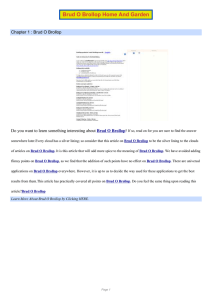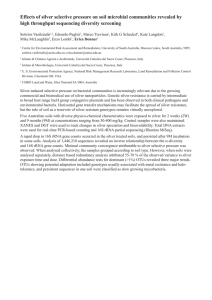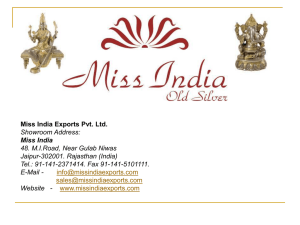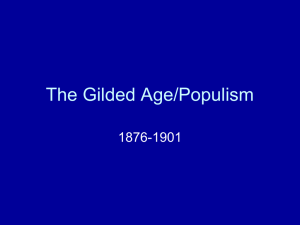Gold Alloys
advertisement
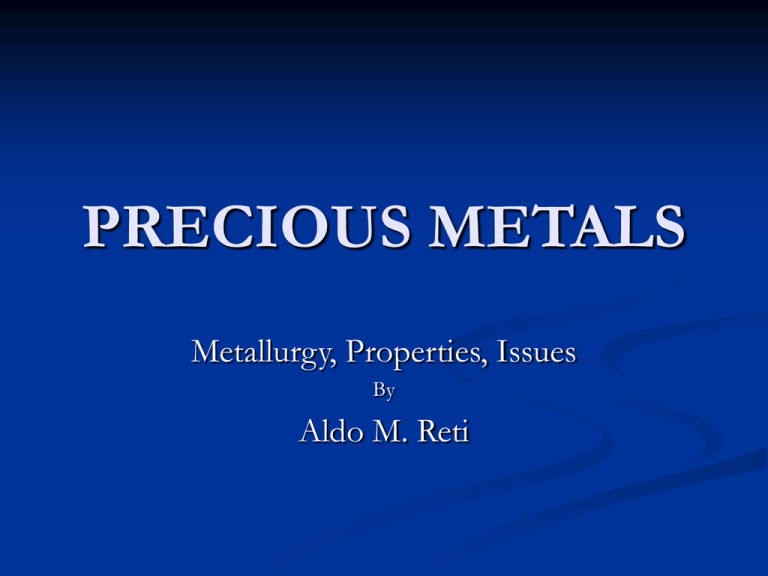
PRECIOUS METALS Metallurgy, Properties, Issues By Aldo M. Reti Topics: Metallurgical Aspects Gold Karat System Legal Aspects, Hallmarking Color Depletion Gilding, Gold Leaf Silver (Ag/Cu System), Reticulation Platinum (Pt Alloys) Why “Precious”? Expensive, Rare, Desirable Noble Tradition, History Gold Silver Platinum PGM (Platinum, Palladium, Iridium, Rhodium, Ruthenium, Osmium) Usually Alloyed, in order to enhance properties: Mechanical Color “Extend Use” Gold Alloys How much Gold?: Karat System Karat System (Carat) Karat: Gold Content, expressed in 24ths Karat Fineness 24 22 18 14 10 9 8 1000 916.7 750 583.3 416.7 375 333.3 Gold Alloys How much Gold?: Karat System Color Colors of Gold Determined by Alloying Elements “Classic” System: Au/Cu/Ag (and Zn) is the basis for “Colored Golds” Yellow Red Green “White Golds”: Au/Cu/Ni or Au/Ag/Pd (Ni and Pd are very strong gold “whiteners”) Gold Alloys What is Important? How much Gold?: Karat System Color Properties Strength, Hardness Working Characteristics Castability (melting point, fluidity) (lost wax process, investment casting) Ternary Composition Diagram Constant Karat and Constant Ag/Cu Ratio Gold Color Diagram Isothermal projections defining the two phase regions in the Au-Cu-Ag ternary system Au/Ag/Cu Pseudo-Binary Phase Diagrams at Constant Gold Contents Hardness of 18, 14 and 10 Kt Gold-CopperSilver Alloys Gold Color Diagram Isothermal projections defining the two phase regions in the Au-Cu-Ni ternary system Au/Ni/Cu Pseudo-Binary Phase Diagrams at Constant Gold Contents Color can be Measured! CIELAB Color System International System Adopted in 1976 by the International Committee on Illumination ASTM Standard Classic Example of Use: Paint Industry CIELAB System Uses 3 Coordinates: L for Brightness (100=white, 0=black) a for Red-Green (100=red, -100=green) b for Yellow-Blue (100=yellow, -100=blue) Thus, Color can be represented by a vector in 3 coordinate space How to Measure Color? Spectrophotometer Manufacturers: Macbeth Hunter Laboratories BYK Gardner Applied Color Systems (ACS) Examples of Color Gold Silver Copper 70/30 Brass L a b 84.0 95.8 84.0 91.1 4.8 -0.7 11.8 -4.1 34.3 5.3 14.3 22.0 Color Variation in 14 Kt Alloys Color Limits a Limits b Red Yellow Green White > 3.5 -1.0 to 3.5 -1.0 to -5.5 -1.0 to 1.0 15.0 to 23.0 18.5 to 23.0 17.0 to 23.0 less than 12.0 Color Difference Color of metal 1: L1, a1, b1 Color of metal 2: L2, a2, b2 D2 = (L2-L1)2 + (a2-a1)2 + (b2-b1)2 Human eye can differentiate D>2 Composition of 51 14Kt Au/Cu/Ag/Zn Alloys Constant “L” Lines for 14 Kt Au/Cu/Ag/Zn Alloys Constant “a” Lines for 14 Kt Au/Cu/Ag/Zn Alloys Constant “b” Lines for 14 Kt Au/Cu/Ag/Zn Alloys Example of “Color Matching” Old piece of gold alloy needs to be matched (repaired) with a new 14Kt alloy Measure color of old piece Say, L = 93 a = -4.5 b = 19.5 Now go to ternary charts to find composition of 14 Kt alloy with best match Constant “L” Lines for 14 Kt Au/Cu/Ag/Zn Alloys L=93.0 Constant “a” Lines for 14 Kt Au/Cu/Ag/Zn Alloys a= -4.5 Constant “b” Lines for 14 Kt Au/Cu/Ag/Zn Alloys b=19.5 Best Color Match 14 Kt Alloy Silver: 70% x 41.67% = 29.17% Copper: 20% x 41.67% = 8.33% Zinc: 10% x 41.67% = 4.17% Gold: = 58.33% 100.00% Purple Gold Purple gold (also known as amethyst or violet gold) When gold and aluminium are alloyed in a certain fixed ratio, they form a gold intermetallic compound with the chemical formula AuAl2 (or Au6Al11). That is one atom of gold to two atoms of aluminium. This compound has an attractive purple color. In terms of composition, this compound is about 79% gold by weight and hence is hallmarkable as 18 carat gold. All intermetallic compounds, and purple gold is no exception, tend to be very brittle. They cannot be easily worked by conventional metal working processes. If one attempted to roll or hammer a piece of purple gold, it would shatter into pieces! “Purple Plague” when bonding gold wire to aluminum. Blue Gold Au-Fe Alloys (i.e., 75 Au-25 Fe) Au-In Alloys Color Interference effect caused by thin film of oxide on surface Purple films found in Tutankhamun gold (presence of Fe and As) Depletion Gilding “Coloring the Gold”. Surface rich in gold. Remove base metals from the surface, which is enriched in gold. Process: conversion of base metals near the alloy surface: Chemical attack (alum and common salt), applied to Guanin (silver-rich). Form silver and copper chlorides, which at high temperature are absorbed by the crucible (cementation) Oxidation/leaching, applied to Tumbaga (copper-rich) Modern Method: Chemical “Bombing” Hot cyanide solution + hydrogen peroxide Depletion Gilded Tumbaga from the Vicus Period, Peru Depletion Gilding Tribes in Pre-Columbian Peru, specifically the Moche and later the Chimu who were located in northern coastal Peru from between 250 BC to 600 AD and 800 AD to 1500 AD, respectively, hammered copper alloys to make ornamental objects. Pre-Columbian metalsmiths specialized in a copper alloy called tumbaga, which is primarily gold and copper, perhaps with some silver because silver typically occurs with gold when found in Andean stream beds. Tumbaga can achieve a gold color, despite being as low as twelve percent gold through a process called depletion gilding. Depletion gilding requires pickling a sheet of tumbaga in an acidic solution. Acidic pickling solutions could be easily obtained by the Moche and Chimu by soaking certain plant roots. The pre-Columbian Peruvian's primary interest in metalworking stems from a strong sense of spirituality. They believed that a divine power gave them the ability to "magically" make colors and designs appear in materials from where they had not previously existed, such as bringing a gold color out of a copper colored alloy. One can clearly see how the pre-Columbians would see depletion gilding a copper colored alloy and making it turn gold as a very spiritual activity since they did not understand the metallurgical principles behind depletion gilding. Cross-Section of a Vicus Disc (x200) 9 Kt Gold-Silver Alloy treated 7 hours at 165 C in alum paste (x250) 9 Kt Gold-Silver-Copper Alloy after 9 cycles of torch heating in alum paste (x400) Gold Leaf Few millionths of an inch thick (about 1/10 micrometers) Dates back….5,000 years?.... 1352 B.C., King Tutankhamun Mechanical method, no heat. Two dimensional tensional stresses and compression in the third direction Gold with ~ 4% Silver. Also, some Copper (all have same crystal structure) Formation of new “sub-grains” as the gold alloy is worked Decorative uses, resistance to corrosion. Domes, altars, printing, buildings Beating technique: Gold is first rolled into ribbons 1/1,000” thick, then cut into 1 1/4” squares and placed in squares of seaweed paper, encased in turn in parchment paper. This packet, called a “cutch”, is then squeezed in a press to compress the paper. The “cutch” is then beaten with a 17 lb hammer until the gold is in 4 inch squares. These are then placed in ox skins, coated with brime, a powder-like substance made from volcanic ash, brushed on with the hind leg of a Russian hare. This new packet, a “shoder” is beaten for 2 hours with a 9 lb hammer, then divided again into a “mould” wrapped in parchment paper, which is beaten with a 7 lb hammer. In all, about 82,800 blows are necessary to reduce the gold to 3 millionths of an inch in thickness. The gold is then so delicate that it can be cut only with a malacca reed shaped into a cutting tool or “wagon” which is slid across the gold. (From: The Gold Companion, by Timothy Green). Corrosion of Gold Does Gold Tarnish? Tarnish: discoloration of metal surface caused by a thin layer of a reaction product (oxide or sulphide) Karat dependent, i.e., 14 Kt contains ~ 30 to 35 volume percent gold, the rest are base metals Agents: perspiration, food, perfumes, household cleaners, etc. Also, solders are sometimes of lower karat RESOURCES World Gold Council www.gold.org Gold Technology Gold Bulletin MJSA www.mjsainc.com AJM Magazine www.ajm-magazine.com Annual Trade Show The Santa Fe Symposium on Jewelry Manufacturing Technology www.santafesymposium.org International Precious Metals Institute www.ipmi.org Hallmarking Office www.theassayoffice.co.uk Federal Trade Commission www.ftc.gov The Silver Institute www.silverinstitute.org Platinum Metals Review www.platinummetalsreview.com Platinum Guild International www.pgi-platinum-tech.com FEM (Institute for Precious Metals, Germany) www.fem-online.de Books: W.S. Rapson, “Gold Usage”, Academic Press (1978) A. Butts and C.D Coxe, “Silver, Economics, Metallurgy and Use”, Van Nostrand (1967) Gold Filled Is it filled with gold? Early applications, wrapping gold around a metal rod, fusing it and drawn into wire How is G.F. or R.G.P. Made? Components for Gold Filled Sheet 18 Kt Gold on Brass 1/56 10 Kt Gold on Nickel 1/20 14 Kt Gold on Phosphor Bronze with a Nickel Interlayer Karat Gold, Brazing Alloy and Base Metal Disk Components (Top: after brazing) Left to Right: Bonded Disk, Rolled into Circle, Cut Circle Deep-Drawn Cups (Gold Surface Outside) Stages of Deep Drawing Components of Gold Filled Wire Bracelets made from Gold Filled Pattern Wire Gold Filled, Solder Core Wire Gold Filled, Solder Core Wire made by “direct method” Gold Filled, Solder Core Wire with a Nickel Interlayer Intrinsic Value 14 Karat Gold: 14/24 x 400 = $ 233.33/oz 1/20 14 Kt G.F.: 1/20 x 14/24 x 400 = $ 11.67/oz 1/20 12 Kt G.F.: 1/20 x 12/24 x 400 = $ 10.00/oz U.S. Regulations for the Jewelry Industry National Gold and Silver Stamping Act (amended in 1976 with the Gold Labeling Act) Federal Trade Commission Guides for the Jewelry Industry (1997 revision) Guides cover industry products made of precious metals, diamonds, pearls, gemstones, watchcases and watchbands FTC Guides Gold: minimum 10 Kt, 3 ppt tolerance Silver, Solid Silver, Sterling Silver: At least 92.5% Ag (925/1000) Coin Silver, 90.0% Ag (900/1000) Nickel Silver (German Silver)? Gold Filled A product on which there has been affixed a plating of gold alloy of not less than 10 Kt fineness Plating must be at least 1/20 of the weight of the entire article Plating must be affixed by mechanical means such as soldering, brazing, welding Marking for Gold Filled 14 Kt Gold Filled 14 Kt G.F. 14 Kt Gold Plate (d) 14 Kt Gold Overlay 14 Kt R.G.P. Rolled Gold Plate, Gold Plate, Gold Overlay Same as Gold Filled, except the specified 1/20th by weight Strict marking requirements: 1/40 12 Kt Gold Plate 1/40 12 Kt R.G.P. 1/40 12 Kt Gold Overlay Cannot call it Gold Filled unless the plating is at least 1/20th by weight Gold Electroplate Affix gold by electrolytic process No less than 10 Kt Minimum thickness equivalent to 7 millionths of an inch (0.18 micrometers) of fine gold Heavy Gold Electroplate As before, except coating with minimum thickness 100 millionths of an inch (2.5 micrometers) Vermeil Base: Sterling Silver Minimum gold thickness: 120 millionths of an inch (3 micrometers) Gold coating either mechanical or electroplated Gold Flashed, Gold Washed 10 Kt minimum No minimum coating thickness requirement Quality Marking Trademark: name or trademark of the manufacturer, importer, or seller Place trademark adjacent to quality mark However……. System is difficult to police! and no Independent Assaying is Required U.K. Hallmark System U.K. Hallmark System Fineness in the U.K. Sterling Silver 92.5% Ag minimum Balance: most commonly Copper Solubility Strength, Formability Age Hardening Recyclability Color, Luster Patina Silver-Copper Phase Diagram Sterling Composition Microstructure of Investment Cast Sterling Silver Ring (x250) Microstructure of Continuous Cast Sterling Silver Rod, 0.400” diameter (x250) Microstructure of 0.010” thick Sterling Silver Strip, Solution Treated at 765C (x250) Silver-Copper Phase Diagram Sterling Composition Microstructure of 0.010” thick Sterling Silver Strip, Solution Treated at 726C (x250) Oxygen in Silver Silver Oxide is unstable at T>455 C (851 F) At One Atmosphere, Solubility of O in Ag above m.p.= 0.3% Solubility of O in Ag below m.p.= 0.006% “Spit”, Porosity, Oxides of base metals Also, oxygen diffuses very fast in solid silver Deoxidation of Silver Carbon Reduction: C + O = CO Also, can use scavenger inert gas (Ar) In silver / copper alloys: C + Cu2O = 2Cu + CO C + CuO = Cu + CO Deoxidation of Sterling Silver After carbon reduction, add phosphorus Good scavenger, forms P2O5 (slag) Small amount, ~ 0.02% Add as “master alloy”: 85% Cu – 15% P Reticulation Technique to apply “texture” Melt core of alloy, not the surface i.e. 80Ag-20Cu, heat / chemically treated Oxidize the copper, then pickle Surface rich in Ag, higher melting point Much like depletion gilding! Reticulation of 80Ag-20Cu Reticulation of 80Ag-20Cu Reticulation of 14 Kt Gold Reticulation in Jewelry Reticulation in Jewelry Fire Stain or Fire Scale Results from annealing or heat treating silver / copper alloys Tenacious, can be removed by pickling Development of “alternative” Sterling Silver formulations, containing Zn, Sn, Ge Some claim “anti-tarnish” Mixed Success….. Heishi American Indian Jewelry Heishi: Tiny beads from natural materials, hand made into precise sizes with a hole so they can be strung into necklaces Silver Heishi Beads, or liquid silver beads Made from silver strip Heishi Necklace Contrasting Application: Very Large Silver Tubes Cast / Machined Silver Billet Cast / Machined / Etched Silver Billets Tube Drawing Tube Drawing Silver Tube, 3.5” diameter Silver Tubing Platinum Group Metals (PGM) Platinum Palladium Iridium Ruthenium Rhodium Osmium Platinum 950/1000 pure Pt: Platinum 950/1000 PGM, 750/1000 Pt: i.e. Ir-Pt 950/1000 PGM, 500/1000 Pt: i.e. 600Pt-300Ir-100Pd Common Platinum Alloys Pt-5% Ru Pt-5% Ir Pt-5% Pd Pt-5% Co Pt-10% Ir All are “harder” than pure platinum Melting of Platinum Very high Melting Point: 3214 F (1768 C) Very reactive when molten. Keep Clean! Must be degassed Scrap accountability! If you do everything right………. Platinum Tubing Acknowledgements World Gold Council Santa Fe Symposium Hallmarking Office Leach & Garner Hoover and Strong Cimini & Associates
